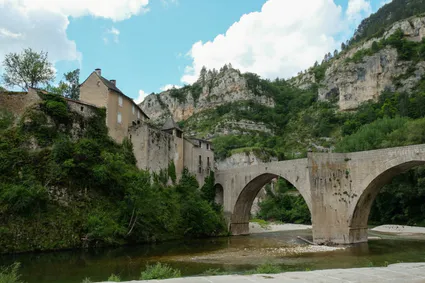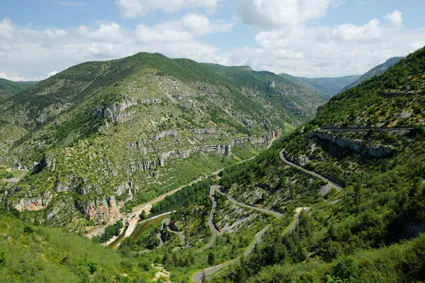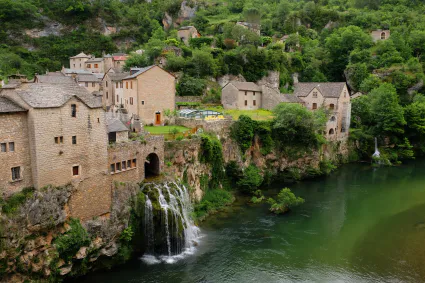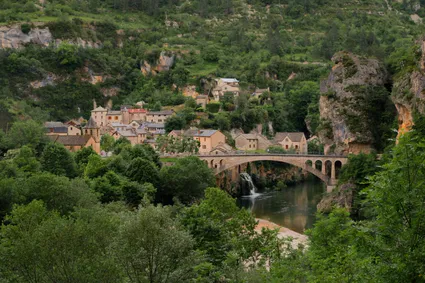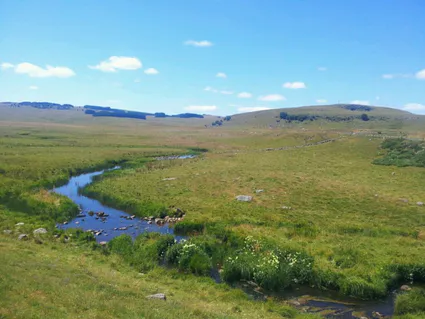Gîtes couleurs et pierres
Visits less than 1 hours away
The cottages offer peace and tranquillity. Situated in the Grand Causses regional park, between the valleys of the Lot, the gorges of the Tarn river, the plateaus of the Aubrac and the Lévézou…
There are countless visits and activities in the vicinity
Roquefort
South of the Grands Causses Natural Park, nestled at the foot of the Combalou rock, is found a unique village. It is here that the famous Roquefort cheese slowly matures in the natural rock face cellars. If you explore the village you must visit the Roquefort maturing cellars, and enjoy a cheese-tasting.
Not to be missed, the visit of the Roquefort maturing cellars will plunge you in the maze of underground tunnels that formed naturally after the collapse of the Combalou mountain.
Turned into large cellars ventilated by the « fleurines », the natural cracks that allow for natural airflow underground, they shelter thousands of Roquefort « loaves », guarded and cared for lovingly the Master Maturers, who hold the secrets of a tradition of a thousand years, or more.
The king of cheeses: a cheese of legends
« Once upon a time, a shepherd was staying in one of the Combalou caves. He was in love, and when he saw his shepherdess, he followed her, and forgot his provisions of bread and ewe’s cheese. When he returned to the place a while later, he found the food covered in mould. He tasted the cheese and found it delicious. Roquefort was born.
Local inhabitants have inherited the secret and kept the tradition alive in the depth of these cellars for more than a thousand years. Each time, the miracle happens.
The Millau viaduc
The Millau viaduct is the most spectacular part of the A75 motorway, that links Clermont-Ferrand to Béziers and Narbonne and that is the most fluid and cheapest route between Paris and the Mediterranean…
Leaning on the north on the Causse Rouge (in the foothills of the Lévézou), and on the South on the Causse du Larzac, the Millau viaduct reaches across the Tarn valley.
A world height record, culminating at 343 metres (higher than the Eiffel tower) and 2460 metres in length, the viaduct touches down on the ground of the Tarn valley in only nine points.
Developed by French engineer Michel Virlogeux and designed by English architect Lord Norman Foster, it fits perfectly in its spectacular natural landscape. Consisting of a very fine metal deck that traces a slight curve, supported by wire stays, it cuts the figure of a sailing ship rising above seven very slender pylons.
Only superlatives can do in describing this wonder of engineering that seamlessly blends into the surrounding landscape.
Gorges of the Tarn river
An incredible sight from all angles. There you can enjoy family canoe trips, swim in crystal-clear waters, observe birds of prey in their natural environment and feast your eyes on the spectacular panoramas.
Pierre Soulages museum
The Soulages museum is home to a unique donation of close to 500 pieces, estimated to 40 million euros. The Soulages museum is the place to see the first painted works by artist Pierre Soulage, the most sought-after of his work.
The Mounts and lakes of the Lévézou
The Mounts and Lakes of the Lévézou
Feeling like a swim or like practising nautical sports? On this vast plateau, situated between the Tarn and the Aveyron valleys, are located no less than six gorgeous artificial lakes, including the lakes of Pareloup, Pont de Salars and Villafranche de Panat. The Lévézou mounts provide them with a cocoon of forests and pastures making this area a favourite holiday place.
Micropolis
The city of insects’ is an amusement park in Aveyron, close to the Millau viaduct. It’s a place to have fun and to learn, for the whole family, where you can discover the world and natural environment of insects through 15 indoor spaces and the outdoor ‘insect carnival’.
The Aubrac plateau
The Aubrac plateau extends over 2500 square km of forests and pasture lands. The move to the summer pastures marks the beginning of the fair season after which the herds of the magnificent Aubrac breed can be seen scattered around the innumerable shepherd’s shelters called « burons ».
Here you will be filled with raw emotions rambling through magical landscapes, where the ever-changing light sculpts curves and rocks, creating a unique atmosphere.
During the winter, the snow transforms this unique steppe into a beautiful Nordic zone, favoured by alpine and cross-country skiers alike.
Laguiole, a knife is born
One of the symbols of Aveyron, the Laguiole knife is world famous. Here bladesmithing is a living and dynamic sector, as the many workshops and shops than can be found in the village attest to.
A mix of tradition and modernity, the skills of the artisan knife-makers that can be admired at the village of Laguiole reveals the real passion of the craftsmen for their work.
Laguiole claims the authentic birthright and the skill of their work-of-art knives. Some workshops can be visited year-round, and let you discover the various stages of manufacture.
Laguiole, a village in Aveyron
Granite and basalt houses with slate roofs surround the imposing bronze bull statue, a symbolic emanation of the placid strength, energy and vigour of the bull of the Aubrac breed.
Laguiole cheese
Contemporary Cheese-making in the Aubrac comes from a very ancient tradition, already practiced in the 12th century by the Dômerie monks. Nowadays, the « Jeune Montagne » (« Young Mountain ») cooperative collects the local milk to make the Laguiole « tome », which comes with its own « Appellation d’Origine Contrôlée » (registered designation of origin.) The famous local dish « aligot » is prepared with young Laguiole « tome ».
Aligot, the traditionnal dish of the Aubrac
A unique traditionnal dish, « aligot » is mashed potatoes mixed with copious amounts of Laguiole cheese and cream, the result a perfectly smooth and stringy delight. A feast for eyes and palate alike!
Aveyron, home to 10 villages awarded the ‘France’s most beautiful villages’ label
Belcastel
On the banks of the Aveyron river, this is a picture-perfect little village with its bridge, church, tomb of the Lords of Belcastel, and the 15th century castle overlooking it all. Architect Fernand Pouillon, marvelling at the beauty of the place, put his passion and talent into renovating the castle.
Brousse-le-Château
At the confluence of two rivers.
The name of the tiny village of Brousse-le-Château calls to mind both the dense vegetation that the first cultivators on the site had to tame, and the fortress that overlooks it, part of which is known to have been built before 1000 AD.
Conques
A major stage on the pilgrimage to Saint-Jacques-de-Compostelle.
Since 1998, the abbatial church of Conques and the bridge over the Dourdou river have been listed on the UNESCO World Heritage list.
Estaing
A medieval town on the eve of the Renaissance.
This most picturesque of medieval cities is nested at the foot of the castle that for centuries has watched over and protected it. On the way to Saint-Jacques-de-Compostelle, Estaing is home to many remarkable buildings: castle, church, Gothic bridge, and village houses, models of medieval architecture.
La Couvertoirade
The jewel of the Larzac.
La Couvertoirade transports through space and time. A fortified surrounding wall, narrow streets, the traditional houses who derive their architecture from the surrounding natural environment, the church sitting on top of a large boulder, the castle, bread-oven… La Couvertoirade is without contest one of the most beautiful villages in France.
Najac
The rich architectural heritage and natural beauty of this fortified town of the Rouergue have allowed this village to be added to the official listing of « France’s most beautiful villages ». Najac also holds the Ministry of Culture’s « Pays d’art et d’Histoire » (« Land of Art and History ») label, and more recently has been awarded the « Great site of the Midi-Pyrénées region », along with Villefranche de Rouergue.
Saint-Côme d’Olt
For centuries a home to Hospitalier knights, the village with the twisting « flaming» bell tower. Medieval architecture, the twisting steeple, rich mansions… retracing the steps of the pilgrim on the road to Saint-Jacques, this old city has remained intact for centuries.
Sainte-Eulalie-d’Olt
Land of tradition
A medieval village on the banks of the river Lot, a land of ancestral traditions, Sainte-Eulalie-d’Olt charms with its pebble houses and flower-covered facades.
Sauveterre-de-Rouergue
A fortified artist’s village.
A royal fortress of the 13th century, Sauveterre-de-Rouergue is built around the largest arcade marketplace of the Rouergue. The village claims unique architecture with Half-timbered, corbelled houses, sculpted stonework, ornate doorways, and vestiges of fortification, moats, towers, old city gates… a journey out of time.
Peyre
An unusual troglodyte village
This rupestrian village is remarkable in many ways : tuff houses, paved street made with the calade technique, troglodyte church. This unusual place, carved out of the cliffside, offers a breathtaking view on the Millau viaduct.
